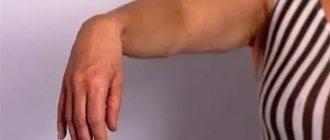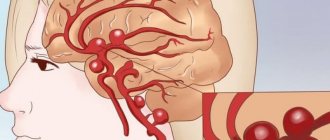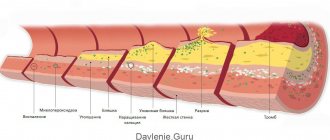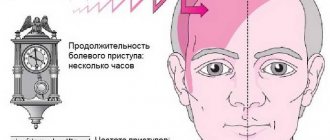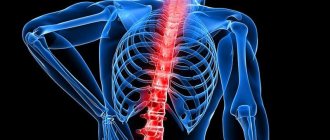What is a nervous tic?
A nervous tic is a type of hyperkinesis - involuntary movement of one or more muscle groups. Twitching of muscle tissue occurs suddenly and also disappears unexpectedly.
Not all forms of hyperkinesis are characterized by pathology. Perhaps all people have encountered such a phenomenon as a nervous tic of the eye. In this case, we are talking about a transient or temporary nervous tic, which occurs in people of all ages. At the same time, involuntary contractions of the eye muscles are the most common neurological problem in children aged 2 to 10 years. Before moving on to considering the causes of nervous tics, it is necessary to delve a little deeper into the process of its occurrence in the human body.
The cerebral cortex contains many areas responsible for specific functions: speech, emotions, movements, thoughts, visual images. All nerve centers in the brain are closely intertwined. The extrapyramidal system is located in the subcortical part of the brain. It is not part of the cortex, but is connected to it through nerve connections. Together they form a single system responsible for functions such as:
- ensuring coordinated muscle movements;
- regulation of skeletal muscle tissue tone;
- maintaining body posture.
There are many types of nervous tics, but they are all associated with disturbances in the extrapyramidal system. A variety of factors can lead to its disorder.
Causes
Depending on the type of tic, the reasons that provoke involuntary twitching of muscle groups differ.
Primary
Primary nervous tics occur in children against the background of:
- Severe trauma . The latter can be chronic, which develops over a long period of time. An example of such trauma can be family relationships when a child experiences negative influence from his parents for several years. The child's body is still in the formative stage. Accordingly, the reaction of the body (brain) to a negative impact manifests itself in the form of a nervous tic, which can persist into an adult.
- Anxious state.
- syndrome . A child with this pathology has a serious imbalance in the nervous system.
- Neuroses.
- Phobias or obsessive fears.
In an adult, primary nervous tics develop as a result of chronic fatigue and severe stress that occurs regularly. Such phenomena lead to exhaustion of the body.
Primary tics in most cases go away on their own and are not accompanied by complications.
Secondary
Secondary tics are complications of a number of pathologies, among which are:
- infectious diseases affecting the brain;
- carbon monoxide poisoning
- long-term use of certain medications (these include psychotropic, anticonvulsants and other medications);
- pathologies characterized by damage to blood vessels (circulatory disorders, stroke, etc.);
- mental pathologies (autism and so on);
- pathologies of internal organs leading to an increase in the content of toxic substances in the body (diabetes mellitus, renal dysfunction);
- tumors of various types;
- trauma at birth;
- vegetative-vascular dystonia, characterized by the fact that different parts of the nervous system work inconsistently with each other.
Secondary tics also develop against the background of regular repetition of the same actions. For example, a prolonged course of sore throat forces the patient to regularly swallow saliva. The action requires strong tension in the muscle fibers located in the throat and neck. After recovery, such swallowing takes on the character of a nervous tic.
Hereditary
This form of the condition in question is called Tourette's disease. Little is known today about how this pathology occurs, as well as what causes contribute to its development.
The only thing researchers are sure of is that Tourette's disease is hereditary. The probability of its occurrence reaches 50% in cases where the pathology is detected in one of the parents.
The first signs of Tourette's disease begin to appear at an early age. As a person grows older, the symptoms of the pathology gradually weaken. The severity of the course is determined largely by the influence on the patient’s body of the following factors:
- poor environmental conditions;
- the presence of autoimmune pathologies;
- infection with a bacterial infection;
- decreased levels of magnesium and vitamin B6 in the body;
- frequent psycho-emotional stress.
It is worth noting that the influence of the above factors on a patient with Tourette's disease has not been proven.
Why does a nervous tic occur most often in the eye?
Nervous tics are vocal and motor, primary and secondary. Involuntary muscle twitching can occur on any part of the body, but most often it appears on the eye. What is this connected with? The reasons lie in the anatomical features of the face and the area around the orbit. There are a lot of nerve endings and muscles near the eyes. The weakest muscles of the human body are located around the orbit. In addition, the face most often displays emotional experiences.
Possible complications
Jerking of a muscle or group of muscles can lead to complex motor tics accompanied by compulsive behavior. Taking serious medications while self-medicating also carries a number of side effects.
Tics are difficult to distinguish from Tourette's syndrome, since in most cases the second diagnosis is mild, so the symptoms cannot always be classified.
A healthy lifestyle, stabilization of the emotional situation and having hobbies related to water or sand help to calm down and not cause your body to become upset. According to statistics, owners of aquariums and Japanese mini-gardens worry and are less nervous at home.
A nervous tic on the face worries a person very much. According to statistics, he is not so concerned about the causes of this condition than about the effect that he can have on others. For example, according to one study, older patients were not at all interested in such “trivial” conditions as nervous facial tics. In this age group, concerns included weakness in the limbs, memory impairment and heart pain. Another important issue was the price of drugs and their availability.
Nervous tics in children: causes and symptoms
According to medical research, tics in one form or another occur in 30% of children. Most often it is observed at the age of 2-10 years. But it also occurs quite often later.
At the same time, boys have nervous tics three times more often than girls. Typically, this phenomenon is typical for the age when a child enters kindergarten or school. These life moments are very important for him and cause a kind of fear, leading to a nervous eye tic. As a rule, it goes away on its own. But in some cases it may persist. Then you need to find out its causes and begin treatment.
The child may not notice the tic. Even if someone draws his attention to the constant blinking, the child will not be able to prevent it. Most likely, contractions of the eye muscles will intensify and become even more frequent.
Nervous tics in a child can be primary or secondary. Primary becomes the result of a disruption of the nervous system. The causes of secondary nervous tics of the eye are the consequences of diseases of the central nervous system. But the most common causes of involuntary twitching of the eye muscles are:
- Emotional trauma. They cause severe fear in the child and lead to nervous disorders. Typical emotional traumas include experiences of violence, conflicts in the family, and stress received in kindergarten or school. Much depends on the child’s temperament and the character that is still being formed. Some children do not express fear and other internal negative emotions, which accumulate and subsequently come out in the form of tics.
- Overwork. It is caused by both great mental stress and lack of adequate physical activity. Play sports, even regular walks, help release emotions. Lack of activity leads to the accumulation of emotions and the appearance of tics.
- Heredity. The probability of inheriting a nervous tic is 50% if at least one parent suffers or suffered from this illness in childhood.
Psychologists note that parental education methods in some cases can be the cause of tics in children. Excessive categoricalness of adults, constant prohibitions, punishments in the absence of warm and lively communication are factors that can lead to great emotional stress.
Emotional stress can manifest itself as an eye tic. At the same time, excessive guardianship, accompanied by interrogations, an attempt to control every action of the child and protect him from all possible and hypothetical “dangers” can cause emotional failure. The likelihood that it will manifest itself in the form of eye twitching is quite high.
The listed causes of tics affect mainly psychological aspects, with the exception of the hereditary factor. However, tic can be a consequence of serious diseases - meningitis, encephalitis, atherosclerosis. Serious head injuries are another very common cause of tics. Such factors also lead to nervous tics in adults, when emotional experiences do not affect a person as strongly as in childhood. In childhood, on the contrary, it is stress and other psychological factors that act as the main causes of nervous eye tics.
Effective treatments
A neurologist and psychologist treat muscle contractions.
Depending on the area of localization of the nervous tic, its cause and degree of neglect, a therapeutic course is prescribed.
Drug treatment
Many people manage to get rid of nervous tics on their own by following a healthy lifestyle and eliminating stress. Sometimes the disorder is caused by another disease. In this case, treatment of a nervous tic should begin with the elimination of the main pathology. Most often, the patient is prescribed sedatives. The following groups of tablets are prescribed for nervous tics:
- tinctures (motherwort, valerian);
- tranquilizers (“Phenazepam”, “Diazepam”);
- antidepressants (“Fluoxetine”);
- psychotropics (“Pimozide”, “Haloperidol”).
Pregnant women should not take any medications for hyperkinesis on their own; regarding therapy, they should consult a gynecologist.
If a neurotic tic is caused by stressful situations, or having experienced violence in childhood, you should seek help from a psychotherapist. The specialist often uses behavioral and family therapy. Using these techniques, you can remove the psychological causes of involuntary spasms and learn to control muscle twitching. To achieve a positive result, the support of loved ones is very important.
In rare cases, surgery and the use of Botox to relax the muscles are required. A method of deep brain stimulation is at the development stage. It is used only in severe cases.
Folk recipes
There are several remedies available to help relieve eye strain at home:
- It is recommended to breathe in essential oils of cinnamon, lavender and cranberry. They are added to the bath.
- You need to lie on your back, close your eyelids and form the letter “s” with your lips.
- You can make medicine from geranium. To do this, brew three leaves in a glass of boiling water. The resulting composition is drunk throughout the day in several doses.
- If eye tics are caused by fatigue, you need to mix a small spoon of honey and one and a half glasses of hot water. A cotton swab is moistened with the resulting composition and applied to the organs of vision for ten minutes.
Before using traditional methods, you should consult a doctor.
Exercises
Special exercises called “Butterfly” will help get rid of nervous eye tics. They do them as follows:
- imagine that the eyelids are the wings of a butterfly;
- blink them five times;
- close their eyes tightly and open their eyes sharply;
- repeat the steps until they start to cry;
- cover the eyelids and massage them;
- blink for forty seconds;
- lower their eyelids halfway, trying to stop trembling;
- close your eyes and massage the skin folds again.
These exercises are suitable for both adults and young patients.
Correct menu
A balanced diet will help eliminate the tic much faster, regardless of the area in which it appears.
It is important to eat foods rich in glycine, calcium and magnesium. These include:
- cheese;
- dairy products;
- bread products with bran;
- buckwheat;
- cilantro;
- dried apricots;
- rabbit meat;
- beet;
- red berries;
- beans;
- bulb.
These are affordable products that help compensate for the lack of important substances. It is worth limiting the consumption of hot and spicy spices and Coca-Cola. It is useful to supplement the daily menu with grapes, peaches, apricots, spinach, watermelon, nuts, and quail eggs.
Other causes of nervous tics in adults
In adulthood, involuntary blinking and contractions of the muscles of the eyes and face are caused by:
- excessive strain on the eyes caused by prolonged work at the computer and reading books;
- injuries;
- pathologies of the central nervous system;
- depression, stress, neurosis;
- lack of vitamins in the body;
- vegetative-vascular dystonia;
- somatic diseases;
- side effects of medications.
Some doctors associate the appearance of tics with liver disease. In fact, this phenomenon is still being studied. Nervous system disorders are quite complex diseases that require an integrated approach to study. Now let's look at the symptoms and treatment of nervous tics.
Diagnosis of twitching
To make a correct diagnosis, a nervous tic should be able to be distinguished from motor acts generated by other causes, including other types of hyperkinesis. Certain movement disorders may occur with Down and Klinefelter syndromes.
An electroencephalogram is prescribed when it is necessary to distinguish tics from convulsions. To rule out brain diseases, an MRI is prescribed. To “weed out” the possibility of hypothyroidism, the amount of thyroid-stimulating hormone in the body is measured.
If nervous tics debut suddenly in adolescents or adults, a urine test may be prescribed to possibly detect traces of drugs: in certain cases, drug addiction can also provoke the appearance of tics.
It is important to collect anamnesis, as well as interview the patient’s family members. In the latter case, for example, studying the condition of the liver in the patient and relatives helps to exclude Wilson's disease. In certain cases, it is also necessary to examine the patient’s stool and blood: movement disorders can be caused by helminths or infectious diseases.
Symptoms of eye tics
The symptoms of tic are very pronounced. Twitching of the eye muscles and frequent blinking are visible to the naked eye. They arise suddenly, and also suddenly the nervous tic goes away. At the same time, there is no system in the appearance and disappearance of involuntary muscle movements.
In this regard, they cause particular discomfort. A nervous tic may begin during an exam, work, or other important event. Because of this, the person worries even more, and the tic symptoms intensify. It often occurs during strong excitement, close attention from others, or danger. Although for some people, tics appear during the rest period, when the body muscles are as relaxed as possible. The peculiarity of a child’s tic is that he may not pay attention to it. In adulthood, such phenomena are noticed immediately. The duration is also uncontrollable, as are the main symptoms of a nervous tic. Twitching of the eye muscles can last for seconds or minutes. Sometimes this condition lasts for several days.
A nervous tic happens all the time - what to do?
If a nervous tic occurs constantly, you should go for examination to a doctor. There is no point in going to an ophthalmologist, since tic is not an ophthalmological disease. First you need to visit a therapist who will give you a referral for tests, based on the results of which other studies will be prescribed. In most cases, encephalography of the brain and ultrasound examination of the abdominal organs, especially the liver, are required.
The results of tests to determine the microelements missing in the body may be important for diagnosis.
Based on the results of the examination, treatment is prescribed. It consists in eliminating the main cause of the nervous tic, which is just a symptom.
Treatment of nervous tics
This disease is treated comprehensively using three methods: medications, special exercises and folk remedies. Medicines, traditional medicine and exercises help to completely get rid of tics or eliminate them quickly every time they appear. The most common medications prescribed for nervous tics are motherwort and valerian. They are sold in the form of tablets and infusions.
Such drugs are available without a prescription, but the instructions for use must be strictly followed, since these drugs in large quantities can cause fatigue and increased drowsiness.
Valerian and motherwort are taken in courses. They have a cumulative effect that is felt about a week after administration. This effect is the normalization of sleep and general calmness, and eye twitching occurs much less frequently when taking them.
Also, if there are problems in the functioning of the nervous system, it is recommended to take drugs containing magnesium and calcium, which are involved in the process of transmitting nerve impulses.
In rare cases, the doctor prescribes Botox injections, which gives elasticity to the eye muscles. Therefore, nervous twitching will be invisible to others.
This procedure is prescribed only to adults and helps eliminate only a cosmetic defect. Many people begin to have complexes about this, which does not contribute to treatment. In severe forms of the disease, when a nervous tic appears very often and greatly complicates a person’s life, courses of psychotherapy are prescribed.
Treatment of motor and vocal tics in Saratov
Treatment of tics should be comprehensive. It is necessary to take into account the types of tics, the stage of the disease, the individual characteristics of the patient’s nervous system, and the social situation in the family. Optimization of the daily routine, psychological correction and training, and drug therapy are mandatory. Doctor Sarklinik has been successfully using hardware and non-hardware methods of treating tics for many years. Treatment is being carried out for vocal tics in Saratov; — sound ticks in Saratov; - motor tics; - motor tics; - tic disorders; - clonic tics; - tonic tics; - dystonic, tonic-clonic tics; - turretism; - Tourette's syndrome. As a result of therapy, there is an improvement in the motor and emotional spheres, motor and sound tic-like movements disappear. The effectiveness of treatment depends on the individual characteristics of the child, adolescent or adult, the severity of symptoms at the time of treatment, the age of the patient, and the intensity of treatment. Treatment is carried out on an outpatient basis, in courses. Under no circumstances should you scold children; if you notice any of the symptoms we mentioned above, it is better to consult a doctor. And remember that treating tics is a very complex process that requires persistence, persistence and time. Your child needs care, attention, understanding and help from you! Don't blame your child or yourself. Complex treatment will give positive results. On the sarclinics website you can ask a doctor a question about your problem online for free.
Sign up for a consultation. There are contraindications. Specialist consultation is required.
Text: ® SARCLINIC | Sarclinic.com \ Sarсlinic.ru Photo 1: © zurijeta / Photobank Photogenica / photogenica.ru Photo 2: © altanaka / Photobank Photogenica / photogenica.ru The people depicted in the photo are models, do not suffer from the diseases described and/or all coincidences excluded. When using materials from the site sarclinic.ru, an active hyperlink is required!
Related posts:
Encopresis in children, neurotic encopresis, treatment of encopresis
Cerebral palsy in children, children with cerebral palsy, treatment
Perinatal encephalopathy, consequences, treatment
Vegetative vascular dystonia in children, treatment of VSD in Saratov
Tics, nervous tics, treatment, hyperkinesis, hyperkinesis treatment
Comments ()
Treatment of teak with folk remedies
Traditional medicine advises making compresses from herbs that have a calming effect. Compresses made from tea, chamomile and nettle decoctions, and bay leaves are perfect for relieving fatigue and tension from the eyes. A cold compress, as well as lotions made from melted honey, can reduce twitching. A wonderful relaxing effect comes from taking a bath with sea salt and various oils.
It is clear that a one-time use of compresses will not cure a nervous tic, much less the disease that provoked it. But it is possible to stabilize the emotional background in this way. This contributes greatly to healing.
Prevention of nervous tics
You can reduce the likelihood of developing a nervous tic by maintaining a healthy lifestyle. You need to exercise, eat right, take a break from work more often and be in the fresh air. Giving up bad habits should be the first preventive measure. Proper organization of working time is another important step that every person should take. Also, nervous tics rarely occur in people who follow a sleep and rest schedule.
We examined the main issues related to such an ailment as nervous tics: causes, symptoms, treatment in adults and children. In conclusion, it is worth noting that a nervous tic in itself is not dangerous. It does not affect the functioning of the nervous system, much less other organs. However, a nervous tic can signal pathologies that require treatment. Do not ignore this symptom.
Prevention
The prognosis for the development of the pathological condition in question directly depends on the severity of its course and the causes of development. By regularly observing preventive measures that involve reducing the negative impact on the patient’s psyche and improving the diet, stable remission can be achieved.
A nervous tic is a harmless but unpleasant pathological condition. It is characterized by the occurrence of involuntary contractions of various muscle groups.
In children, such phenomena often go away without the intervention of specialists. The healing process can be accelerated by normalizing the psycho-emotional state and taking a number of medications.
